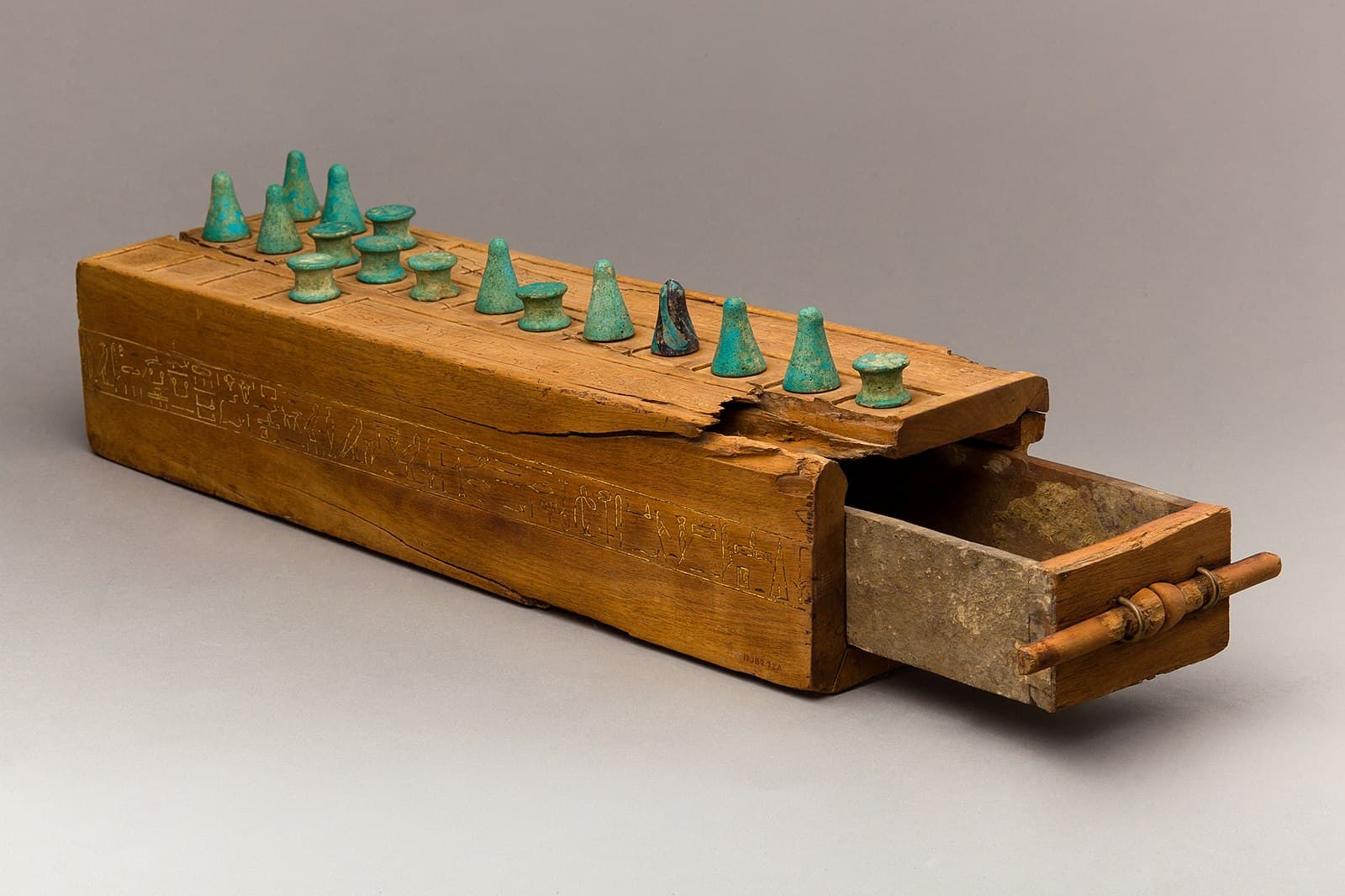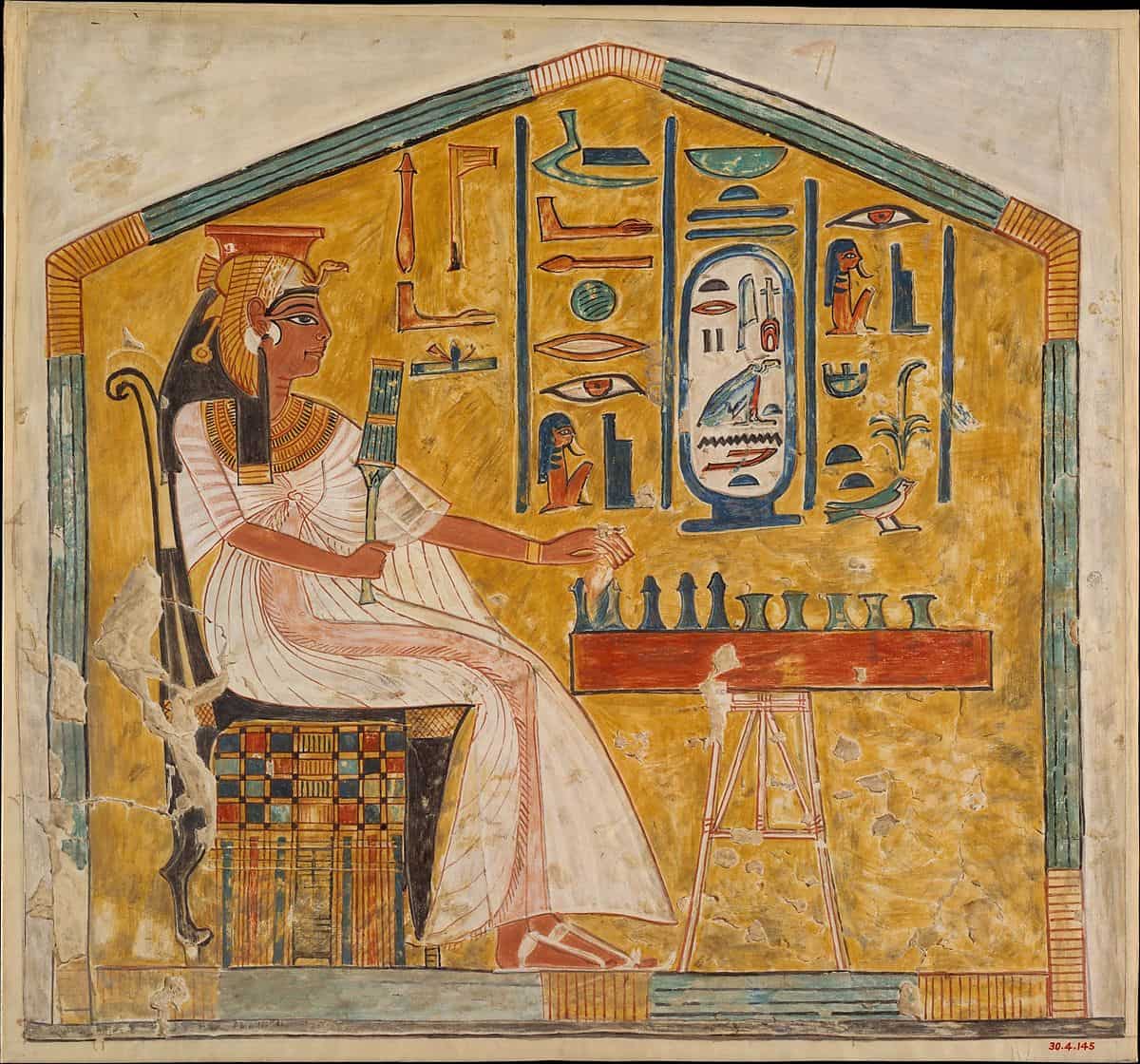Visitors to the Metropolitan Art Museum in New York, when learning about the history of Ancient Egypt, stumble upon a strange sight. A hinged rectangular box made of wood, decorated with squares of lapis faience, sits in the display window, measuring about 16 inches long and 5 inches wide.
Its decorated glazed squares stand scattered with small wooden pieces reminiscent of chess pawns and little tables reminiscent of checkers. The visitor might think that it is undoubtedly some kind of ancient board game, but what is it? And how was it played?

Egyptian; Abydos, New Kingdom
Faience, wood (restoration); Restored box: l. 43 cm (16 15/16 in); w. 13.5 cm (5 5/16 in); h. 9 cm (3 9/16 in)
The Metropolitan Museum of Art, New York, Gift of Egypt Exploration Fund, 1901 (01.4.1a)
http://www.metmuseum.org/Collections/search-the-collections/544775
Senet
The board game that is now primarily recognizable for its place in museums across the world is called Senet. The word Senet derives from two separate words: znt, meaning “passing” in Ancient Egyptian, and sinə, meaning “afternoon” in Coptic.
The name, Senet, then, is apt; for a board game, there is likely no appellation more fitting than “a thing whereby one passes the afternoon.”
Much of the rules are subject to conjecture because we are only left with fragments and a limited number of paintings detailing Senet’s gameplay.
Some academics even question whether the game Senet can be played correctly if the rules are lost. If playing with rules other than those used by the Ancient Egyptians, is it the same game?
The History Of Senet
The earliest known mention of a board game called Senet dates back nearly 5,000 years, to 3100 BCE. This makes it one of the earliest board games ever played, although other ancient games like Mehen and Backgammon date to this era.
Archaeologists believe that Senet was likely played by upper-class Ancient Egyptians who, free from the labor of the fields, had free time for leisure and gaming.
Peter Piccione of the University of Waterloo makes a convincing argument that the game mechanics of Senet evolved to hold a symbolic relationship to the Ancient Egyptians’ spiritual beliefs over time. The mechanics of the game and its rules took the players on a journey to unite themselves with the God of the Rising Sun, Re-Horakhty.
3100 BCE places Senet’s conception right at the end of what’s called the proto-dynastic period of Egypt’s history and right at the onset of Egypt’s more famous dynasties.

We know that later Pharaohs played senet, as the tomb of Tutankhamun contained within it an elaborate Senet board that the young Pharaoh likely played.
Senet spread around parts of the ancient world, and references to the board game have been found across the Levant.
By the Roman Empire, the use of Senet fell off, and its rules fell into obscurity. Supposedly the game had taken on a religious aspect with the Ancient Egyptians. In that case, we can see quite easily how a Rome preparing for the hegemony of Christianity in the West might have neglected and forgotten about this ancient game.
How To Play
Senet is a game for two people who compete by moving their pawns across a board while trying to prevent their opponent from moving their own.
As the rules are open to conjecture, there are various theories about how to play Senet. The following gives a sample ruleset, made as accurate as possible while being easy to pick up and fun to play.
Game Components
Senet consists of:
-
A board: The senet board consists of 30 squares: 3 rows of 10 squares each. Some of these squares have unique markings, which we’ll get into later.
-
Four “casting sticks”: These sticks, when thrown, can land on one of their two sides. The two sides are colored to be dark and light.
-
A total of 10 pawns, five for each player: The white pawns are in the shape of a cone, while the dark pawns are in the shape of a spindle.
Objective
The game objective is to remove all your own pawns from the board.
Playing the Game
To set up the board, players place all of their pawns alternatingly along one row of the gameboard. Each pawn should have two squares in front of it, and every pawn should be next to a pawn of the opposite color.
Looking down on the game board with the row of pieces at the top, players move their pieces in a reverse S pattern along with the squares of the game board.
The square to the far right of the first row, called square 10, directly precedes the square to the furthest right of the second row, called square 11. The square to the furthest left of the second row, square 20, directly precedes the square to the furthest left of the third row, called square 21.
The players’ goal is to move all their pawns to the end of the board. When a pawn has reached the end of the board, the player takes it off of the board.
To move a pawn, a player must throw the casting sticks. The possible casting stick throws and their point value is detailed below.
-
1 light and 3 dark: Player gets to move a single pawn 1 square and that pawn or another one 1 square.
-
2 light and 2 dark: Player gets to move a single pawn 2 squares.
-
3 light and 1 dark: Player gets to move a single pawn 3 squares.
-
4 light and 0 dark: Player gets to move a single pawn 4 squares and that pawn or another one 1 square.
-
0 light and 4 dark: Player gets to move a single pawn 5 squares and that pawn or another one 1 square.
When moving pawns, your pawn may pass an inhabited square, but no two pawns can share a square on the gameboard. If you move your pawn on your turn and land on a square already inhabited by your opponent’s pawn, you are said to attack that pawn. An attacked pawn moves back to the square from which your piece originated. A player cannot attack their own pawn.
If two or more pawns of the same color are next to each other, these pawns protect each other and cannot be attacked. While two pawns on the corners protect each other (for example, two pawns on squares 10 and 11), two pawns that are adjacent but on two separate rows do not protect each other, as actually, these pawns are many moves away from one another.
During play, you must move forward if you can. If you cannot, you must move backward. If none of your pawns can move forward nor backward, you lose your turn.
Pawns on the last four squares in the last row do not protect each other, and these pawns face special rules.
Special Squares
There are five special squares: square 15, “The House of Second Birth,” square 26 “The House of Beauty,” square 27 “The House of Waters,” square 28 “The House of Three Judges,” square 29 “The House of Two Judges,” and square 30 “The House of Horus.”
-
The House of Beauty: All pawns must land here with an exact throw to proceed to the end of the game. A player cannot move a pawn to or past the House of Beauty until it has landed on the House of Beauty.
-
The House of Waters: A pawn that lands here on an accurate throw is said to be drowning. All other movements end, and the player’s turn therefore ends. When you begin your turn with a pawn drowning, you must deal with that pawn.
Dealing With a Pawn on The House of Waters:
-
If you begin your turn with a pawn on The House of Waters: You may attempt to roll a four (all-white casting sticks), at which point the player takes the pawn off of the game board, and play continues.
-
Alternatively you may move your pawn back to The House of Second Birth on square 15.
-
If you choose to roll four white casting sticks and fail, your turn immediately ends.
-
The House of Second Birth: A pawn may be returned to the House of Second Birth if a player decides not to try their luck on the House of Waters with a throw of four. If a player makes this decision, but another pawn occupies The House of Second Birth square, the pawn that began its turn on the House of Waters returns to the first available square before the House of Second Birth (e.g., square 14, 13, 12, etc.).
-
The House of Three Judges: A pawn that lands here may not move forward or backward but may only be borne off the board with an exact roll of three.
-
The House of Two Judges: A pawn that lands here may not move forward or backward but may only be borne off the board with an exact roll of two
-
The House of Horus. A pawn that lands here may be borne off the board with any roll.
Additional Rules
Even if pawns of the same color occupy the last three squares, these pawns do not protect each other. If a player lands their pawn on an opponent’s pawn in one of these squares, that pawn is placed in The House of Waters. If there is already a pawn in the House of Waters, that pawn is returned to The House of Beauty.





Show Comments